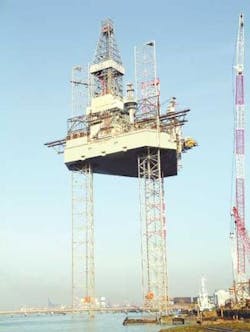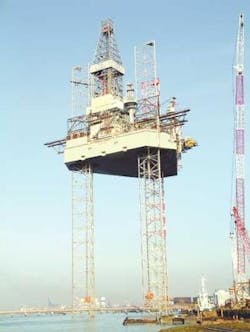New vessels, rigs, upgrades
Judy Maksoud Houston
Ultra-premium jackup
GlobalSantaFe's new ultra-premium jackup, the Constellation I, has broken new ground. The 548 ft of leg gives the jackup water depth capability that puts it in an elite class of rigs. And its unique features put it in a class by itself, according to Steven Gangelhoff, vice president of business development and market analysis at GlobalSantaFe.
The Constellation I is the first rig of its kind, according to Matt Hemker, project manager at Friede & Goldman Ltd. The design objectives for the JU 2000 rig "exceeded previously set benchmarks." The new design fills a niche between the lesser depth rated ultra-premium jackups and the heavy-duty harsh environment rigs.
The limitations in the current fleet of premium jackups led GSF to go a step beyond in the design of the Constellation I. Some of those limitations preclude rigs from drilling below 20,000 ft in highly directional wells, dealing with higher pressures, and working around salt domes, Gangelhoff said.
"One thing I think we can bank on is that as time goes by, oil companies will continue to seek ways to reduce finding cost, and the main way they will do that is to find bigger reservoirs they can produce from one location. Those bigger reservoirs are going to be deeper and more difficult to get to. We had the vision to build a rig that can drill deeper, faster, and with longer reach than existing jackups," Gangelhoff said.
The key components of the design are increased operational capability and deck space to accommodate an automated pipe handling system and extra storage. The jackup was also designed with superior environmental ratings in mind.
null
A number of features set the Constellation I apart from other jackups. "Deck space on jackups is at a premium," Hemker said. Therefore, a critical design objective was to increase the amount of available deck space on the Constellation I.
According to Gangelhoff, the end result is a jackup with 12,000 sq ft of pipe deck space, compared to the 8,800 sq ft of the F&G L780 Mod VI Galaxy class design or the 10,000 sq ft of the LeTourneau Super Gorilla.
One way F&G engineers opened up more deck space was to position the quarters in a new way, wrapping them around the forward leg of the jackup instead of placing them in the center of the rig as is traditionally done. According to Hemker, F&G introduced the concept of wrap-around quarters in the early '90s. GlobalSantaFe was the first to build it.
Another way to open space was by re-thinking the use of space beneath the cantilever. The Constellation I has a 75-ft-reach cantilever and a 108-ft-long pipe rack deck, which allows the rig to accommodate an automated pipe-racking system. A knuckle-boom crane moves singles of pipe or casing to the pipe-handling system to be made up horizontally into stands using a type of iron roughneck.
Then, a horizontal-to-vertical elevator moves the stands vertically into the derrick. A triple of drill pipe or a double of casing can be held ready in the derrick's pipe-handling system, transferred to a setback area, or set over the well center. Automation reduces safety hazards, while it saves time by moving tubular handling off of the critical path.
The added reach of the Constellation I's long cantilever allows it to service more types of wells and large, multiple-well platforms.
Another singular element of the new jackup design is the use of what Hemker called "dead space beneath traditional cantilevers." On the Constellation I, however, the 60-ft-wide, 100-ft-long, and 28-ft-deep area beneath the pipe rack space is used for mud treatment, cementing, and other equipment. Using the space in this manner reduces piping runs and makes the rig easier to operate, Hemker said.
According to Hemker, F&G also gave serious consideration to construction while developing the rig design. "One big objective was cost efficiency of the design, which in short means they are easy to build," Hemker said. The modular hull of the Constellation I is indicative of that mindset. "Many of the blocks of the main hull are duplicates."
These identical building blocks simplify construction and save time and money in the building process. The modular design also allows equipment, outfitting, piping, and electrical construction to be carried out while the hull is completely open, which cuts down considerably on construction time.
ABS classes three FPSOs for Africa
Single Buoy Moorings has selected ABS to provide classification and certification services for three FPSOs that will work offshore West Africa. ExxonMobil subsidiary Esso Deepwater Ltd. will operate the FPSOs.
The three vessels are conversions from existing very large crude carriers (VLCCs) into FPSOs. When conversion is complete, the vessels will be assigned a new class notation, "A1 Floating Offshore Installation."
The Falcon, formerly the Amazon Falcon VLCC, is equipped with an external turret mooring system and production facilities capable of producing 100,000 b/d of oil and 100 MMcf/d of gas. The vessel is being used as an early production system on the Yoho field offshore Nigeria in 60 m water depth.
The FPSO Eagle, formerly the Amazon Eagle VLCC, will be installed in the Zafiro field offshore Equatorial Guinea in 515 m of water. The Eagle will be equipped with an external turret mooring system and with production facilities capable of producing 110,000 b/d of oil and 95 MMcf/d of gas. It also will be able to import 185,000 b/d of oil from existing facilities in the field. The conversion is scheduled for completion in August 2003.
The FPSO Atlantic, formerly the Atlantic VLCC, will be installed in block 15 offshore Angola to produce the deepwater Xikomba field at a water depth of 1,300 m. The Atlantic will be equipped with an external turret and production facilities capable of producing 90,000 b/d of oil. Nine subsea wells will be tied back to the FPSO. Conversion work has just begun in Dubai, United Arab Emirates. The Atlantic is scheduled for completion in November of this year.

